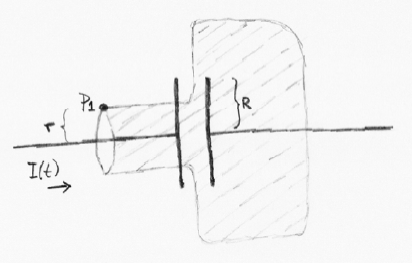In an assignment I'm looking at for exam preparation I am asked to use Maxwell's corrected version of Ampère's law (the integral form)
$$\oint_{loop}\vec{B}\cdot d\vec{l} = \mu_0 \left(I_{encl} + \epsilon_0 \frac{d}{dt} \int_{surface} \vec{E} \cdot d\vec{a}\right)$$
to find the magnetic field in the point $p_1$ in the distance $r<R$ above the wire. There is a current, $I(t)$, running through the wire, the capacitor is circular and has a radius $R$, and the loop is a circle around the wire.
I have to calculate it using this complicated balloon shape given (see the figure below), which I have some troubles with.
What I'm thinking is that the wire is piercing the balloon three different places - to the far right and at the capacitor twice. The piercing on the far right would contribute with $\mu_0I$ from the first part of the equation, but I'm not sure what to the with the other two.
Then comes the surface integral of the $\vec{E}$ field, which I'm not sure how to incorporate either.
Can you come with some tips or explanation that could help me better understand how to use the law on the surface?

